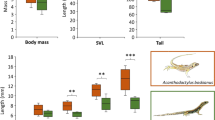Abstract
THE pronghorn antelope (Antilocapra americana) has an alleged top speed of 100 km h−1, second only to the cheetah (Acionyx jubatus) among land vertebrates1, a possible response to predation in the exposed habitat of the North American prairie2. Unlike cheetahs, however, pronghorn antelope are distance runners rather than sprinters, and can run 11 km in 10 min, an average speed of 65 km h−1 (ref. 1). We measured maximum oxygen uptake in pronghorn antelope to distinguish between two potential explanations for this ability: either they have evolved a uniquely high muscular efficiency (low cost of transport) or they can supply oxygen to the muscles at unusually high levels. Because the cost of transport (energy per unit distance covered per unit body mass) varies as a predictable function of body mass among terrestrial vertebrates, we can calculate the predicted cost to maintain speeds of 65 and 100 km h–1 in an average 32-kg animal3. The resulting range of predicted values, 3.2-5.1 ml O2 kg–1 s−1, far surpasses the predicted maximum aerobic capacity4 of a 32-kg mammal (1.5 ml O2 kg−1s−1). We conclude that their performance is achieved by an extraordinary capacity to consume and process enough oxygen to support a predicted running speed >20 ms−1 (70 km h−1), attained without unique respiratory-system structures.
Similar content being viewed by others
References
McKean, T. A. & Walker, B. Resp. Physiol. 21, 365–370 (1974).
O'Gara, B. W. Mammal. Species 90, 1–7 (1978).
Garland, T. Jr J. Zool. 199, 157–170 (1983).
Taylor, C. R. et al. Resp. Physiol. 44, 25–37 (1981).
Rübner, M. Z. für Biol. 19, 535–562 (1883).
Kleiber, M. Hilgardia 6, 315–353 (1932).
Lechner, A. J. Resp. Physiol. 34, 29–44 (1978).
Hemmingsen, A. M. Rep. Steno meml Hosp. 4, 7–58 (1950).
Hemmingsen, A. M. Rep. Steno meml Hosp. 9, 7–110 (1960).
Calder, W. A. III Size, Function and Life History (Harvard University Press, 1984).
Taylor, C. R., Schmidt-Nielsen, K. & Raab, J. L. Am. J. Physiol. 219, 1104–1107 (1970).
Fedak, M. A. & Seeherman, H. J. Nature 282, 713–716 (1979).
Tucker, V. A. Am. Scient. 63, 413–419 (1975).
Schmidt-Nielsen, K. Scaling: Why is Animal Size so Important? (Cambridge University Press, 1984).
Wells, D. J. thesis, Univ. Wyoming (1990).
Longworth, K. E., Jones, J. H., Taylor, C. R. & Weibel, E. R. Resp. Physiol. 77, 263–276 (1989).
Costill, D. L., Fink, W. J. & Pollock, M. L. Med. Sci. Sport 8, 96–100 (1976).
Lindstedt, S. L., Wells, D. J., Jones, J. H., Hoppeler, H. & Thronson, H. A. Jr Int. J. Sports Med. 9, 210–227 (1988).
Carpenter, R. E. J. exp. Biol. 114, 619–647 (1985).
Thomas, S. P. J. exp. Biol. 63, 273–293 (1975).
Tucker, V. A. J. exp. Biol. 58, 689–709 (1973).
Lasiewski, R. C. Physiol. Zool. 36, 122–140 (1963).
Epting, R. J. Physiol. Zool. 53, 347–357 (1980).
Casey, M. in Insect Flight (eds Goldsworth, T. Y., Casey, T. M., Goldswothy, G. J. & Wheeler, C. H.) 257–272 (CRC Press, Bocca Raton, Florida, 1989).
Rothe, H. J., Biesel, W. & Nachitgall, W. J. comp. Physiol. 157, 99–109 (1987).
Tucker, V. A. Science 154, 150–153 (1966).
Weibel, E. R. & Taylor, C. R. Resp. Physiol. 44, 1–164 (1981).
Author information
Authors and Affiliations
Rights and permissions
About this article
Cite this article
Lindstedt, S., Hokanson, J., Wells, D. et al. Running energetics in the pronghorn antelope. Nature 353, 748–750 (1991). https://doi.org/10.1038/353748a0
Received:
Accepted:
Issue Date:
DOI: https://doi.org/10.1038/353748a0
- Springer Nature Limited
This article is cited by
-
Effects of exercise habituation and aging on the intersegmental coordination of lower limbs during walking with sinusoidal speed change
Journal of Physiological Anthropology (2022)
-
Size matters only sometimes: the energy-risk trade-offs of Holocene prey acquisition in the Bonneville basin, western USA
Archaeological and Anthropological Sciences (2020)
-
Myricetin improves endurance capacity by inducing muscle fiber type conversion via miR-499
Nutrition & Metabolism (2019)
-
Thermoregulatory anatomy of pronghorn (Antilocapra americana)
European Journal of Wildlife Research (2009)
-
The pitfalls of power laws
Nature (2002)





